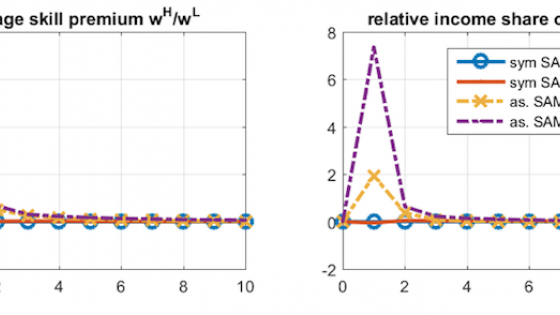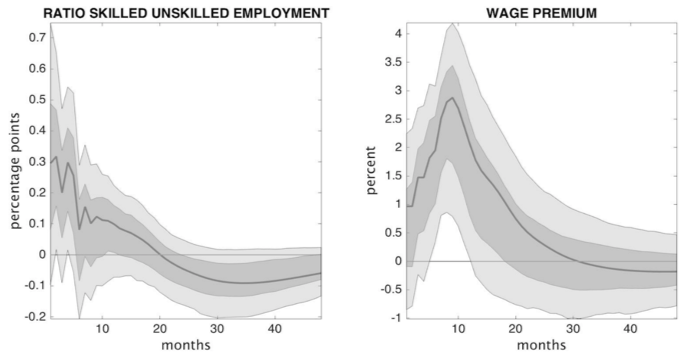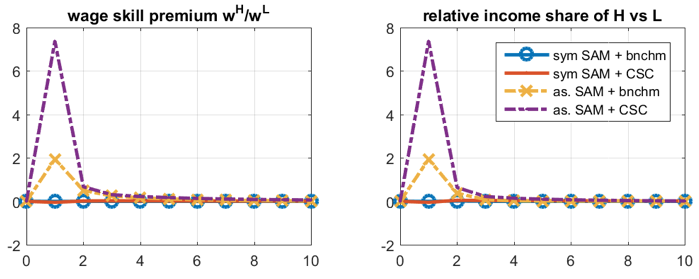Growing inequality has become a trending topic in the public debates occurring in advanced countries. The usually discussed drivers of long-term trends in inequality have been skill-biased technological change, globalisation, and, more recently, automation and artificial intelligence. However, following the financial crisis and the extreme measures central banks adopted to fight it, questions have also arisen on how aggregate policies, and in particular monetary policy, might affect inequality over the business cycle.
There are contrasting views on this issue. On the one hand, there are concerns that unconventional quantitative easing favours richer households disproportionately, thereby contributing to more unequal income and wealth distributions. On the other hand, there are those who think that it has reduced inequality because borrowers became better off than savers.
Of course, central banks consider the economy as a whole when setting monetary policy. As Bernanke (2015) points out, distributional issues should not be the concern of unelected monetary policymakers, but should rather be addressed by elected official through, for example, fiscal policy. A corollary of this way of thinking is therefore that monetary policy can best contribute to social welfare by promoting aggregate economic stability, which is also likely to be beneficial from an inequality perspective.
Notwithstanding the above, it is increasingly acknowledged that the short-run effects of monetary policy on inequality could be relevant for its optimal design. Taking these effects into consideration might have welfare implications for various systematic monetary strategies; likewise, inequality might also interact with the different channels of the monetary transmission mechanism. As a result, a recent body of literature has started to analyse how these two issues are related (Amaral 2017, Coibion et al. 2012, Gornemann et al. 2016).
The channels through which monetary policy affects inequality are complex. Interest rate changes can have different effects on savers and borrowers across the wealth distribution (the savings-redistribution channel). Prices of different assets (with various maturities) can react in different ways to changes in interest rates and/or inflation which can influence the inequality between the holders of these different asset types (the interest-sensitivity channel). Different household preferences and differing financial market access can also introduce heterogeneity in the effects of monetary policy (the household heterogeneity channel). More indirectly, the aggregate demand expansion engineered by monetary loosening can affect the fortunes of workers and capital owners differently, to the extent that wages and profits change by different amounts (the income composition channel). Finally, the wages and employment of different types of workers can also exhibit heterogeneous responses, depending on unemployment risk, asymmetric wage rigidities, and labour market institutions (the earnings heterogeneity channel).
A new channel
The balance of all these forces is ambiguous and thus can only be determined by quantitative methods. In a recent paper we contribute to this literature by focusing exclusively on the earnings heterogeneity channel (Dolado et al.2018). Within this we uncover new mechanisms by introducing some new features in a New Keynesian model with incomplete financial markets. In particular, we focus on the role played by capital-skill complementarity in production, and labour market heterogeneity in the form of asymmetric search-and-matching frictions between high-skilled and less-skilled workers.
Our reasoning is as follows. If high-skilled labour is a complementary input to capital and low-skilled labour can be substituted by a combination of skilled labour and capital, then cyclical changes in aggregate demand induced by an expansionary monetary policy can have markedly different effects on the relative income of these two labour inputs than in the absence of capital-skill complementarity. This is especially the case when these two types of workers are also subject to different labour market frictions whereby low-skilled workers face worse prospects of finding or keeping jobs. In particular, the increase in labour demand induced by a monetary expansion benefits high-skilled workers relatively more as it is worth more to firms to open such vacancies due to their smaller matching frictions (the search-and-matching asymmetry channel). At the same time, the increase in capital demand amplifies this advantage as skilled workers are more complementary to capital than substitutable unskilled ones are (the capital-skill complementarity channel). This advantage could show up in a combination of larger wage (skill) premiums and larger employment gains for high-skilled workers, and could even push the income shares of high-skilled and low-skilled labour in opposite directions. Given that high-skilled workers are already richer, an expansionary monetary policy shock will then increase inequality through this specific channel, which contrasts with the way most researchers interpret the effects of the earnings heterogeneity channel.
With regards to the asymmetric nature of search-and-matching frictions, one potential rationalisation could be that, while low-skilled workers are only able to undertake simple tasks, high-skilled workers can undertake both complex and simple tasks, so that they experience lower job-separation rates. In addition, to the extent that high-skilled workers may look for better jobs when they land in simple jobs, these jobs become more unstable and less profitable for firms (Dolado et al. 2009). Furthermore, to the extent that high-skilled workers have more stable jobs, they are likely to have larger networks helping them to find jobs when unemployed. Finally, it is also plausible that high-skilled workers have greater bargaining power than the less-skilled, since they are more valuable for the firm. With regards to capital-skill complementarity, it has been argued by Krusell et al. (2000) that it is a crucial economic mechanism for understanding skill-biased technological change in terms of observable data.
Some empirical evidence
To motivate our theoretical model, we first look at the effect of an unexpectedexpansionary monetary policy shock (i.e. a 100 basis point cut in the interest rate) on relative labour income (wage times hours of work) of high and less-skilled labour. We consider this to be a measure of inequality. Using monthly US data from January 1979 to June 2016 – (log) industrial production, unemployment rate, log of the skill premium, the relative employment rate ratio, CPI inflation, and the federal funds rate – we estimate a structural VAR (proxy-SVAR) with an extended time series of Romer and Romer’s narrative shocks as an external instrument to identify monetary policy shocks. Workers are classified as high-skilled and low-skilled according to whether they have a college degree or not.
As can be seen in Figure 1, the impulse response functions of the skill premium and the employment rate ratio to the aforementioned shock show that both variables increase, though the response of the latter is less statistically significant. Thus, inequality seems to rise following an unexpected monetary expansion.
Figure 1 Impulse response functions of relative employment and skill premium to a 100 basis point cut in the federal funds rate
Notes: Results from Proxy-SVAR, using Romer & Romer narrative shocks (dark and light grey areas are confidence intervals at the 68% and 90% levels).
Simulations from a calibrated New Keynesian model
In light of this evidence, we build a New Keynesian model where heterogeneity between high and low skilled workers is captured through their asymmetric labour market frictions and the different roles they play in production. In particular, high skilled workers exhibit lower search-and-matching frictions than low-skilled workers in terms of their matching efficiency and separation rates. During the Nash wage bargaining, high-skilled workers are also assumed to have greater bargaining power. On the other hand, production exhibits capital-skill complementarity, with high-skilled workers more complementary to capital than substitutable low-skilled workers are. The rest of the model is standard, featuring Calvo-type nominal rigidities, Mortensen-Pissarides-type search-and-matching in the labour markets, capital adjustment costs, and variable capital utilisation. Different workers are members of separate households who can trade with each other in incomplete financial markets (using a single risk-free bond), which prevents perfect risk sharing among them. Monetary policy is modelled through a Taylor-type rule. The parameters in the model are calibrated to reproduce some relevant targets in the US economy.
As shown in Figure 2, our main finding for the baseline specification of the model is that an expansionary monetary policy shock increaseslabour earnings inequality. This is mainly driven by an increase in the wage premium for the high skilled (i.e. the skill premium). Relative to the benchmark case without capital-skill complementarity (i.e. with a Cobb-Douglas production function) and with symmetric search-and-matching frictions, we find that introducing these two features on their own are not enough to generate these results—it is the interactionof capital-skill complementarity with asymmetric search-and-matching frictions that leads to the larger rise in inequality. It is important to stress that these results are not specific to monetary policy shocks but are qualitatively similar for any positive aggregate demand shock which increases the labour and capital demand of firms. Nonetheless, since monetary policy shocks have a stronger impact on the user cost capital than, for example, government expenditure shocks – due to the investment crowding-out effects of the latter – we argue that their effect on income inequality is larger.
Figure 2 Impulse response functions of relative employment and the skill premium to a 100 basis point cut in the federal funds rate
By comparing Figures 1 and 2, it becomes apparent that the rise in the skill premium is larger (7.5% versus 3%) in the calibrated model than in the SVAR. This is due to the excessive flexibility of wages in the model (the so-called Shimer’s puzzle). By introducing persistence in wage setting we are able to reproduce the quantitative results in the SVAR.
Next, we analyse the welfare effects of favourable monetary policy shocks separately for the different households as well as in the aggregate. The incomplete financial market setup prevents perfect risk-sharing among households, which will lead to fluctuating consumption inequality. Therefore, a change in relative wages can have welfare implications. Not surprisingly, in the absence of our proposed channels, a monetary expansion benefits both types of workers similarly. However, when both capital-skill complementarity and asymmetric search-and-matching are incorporated, the shock results in high-skilled workers gaining much more than low skilled workers do (in fact, the latter are worse offdespite their raising consumption levels, since they also have to work more). The ensuing rise in inequality reduces aggregate welfare by 0.07%. We show that by increasing the degree of capital-skill complementarity or asymmetric search-and-matching frictions, welfare is more adversely affected through a bigger increase in inequality.
Monetary policy rules
In addition to looking at the effect of an unexpected monetary shock, we examine the performance of different systematic monetary policy rules in the face of shocks, introducing a trade-off between inflation and output stabilisation. We find that strict inflation targeting is more successful in stabilising the economy, and thereby in limiting variations in relative income share of the two types of workers than the other rules considered. However, when comparing two versions of a standard Taylor rule, we find that an explicit reaction to unemployment leads to a smaller increase in the skill premium than a policy rule without such reaction. This result is due to the presence of capital-skill complementarity – with a benchmark Cobb-Douglas production function, reacting to unemployment actually leads to a larger increase in the skill premium.
Further research
Lastly, we argue the counterpart implication—that inequality would go down in the face of a contractionary monetary shock—may not hold if high-skilled workers were allowed to search for low-skill jobs, crowding out less-skilled workers. In our model, with a single intermediate good and segmented labour markets, we do not allow for these spillovers across markets. Yet, this issue remains high in our current research agenda since it could lead to asymmetries in the effects of monetary policies on labour income inequality.
References
Amaral, P (2017), “Monetary policy and inequality”, Federal Reserve Bank of Cleveland, Economic Commentary 01.
Bernanke, B S (2015), “Monetary policy and inequality”, blog of Ben Bernanke, 1 June.
Coibion O, Y Gorodnichenko, L Kueng and J Silva (2012), “Innocent bystanders? Monetary policy and inequality in the US”, NBER Working Paper 18170.
Dolado J, M Jansen and J F Jimeno (2009), “On-the-job search in a matching model with heterogeneous jobs and workers”, The Economic Journal 119: 200–228.
Dolado J, G Motyovszki and E Pappa (2018), “Monetary policy and inequality under labor market frictions and capital-skill complementarity”, CEPR Discussion Paper 12734.
Gornemann N, K Kuester and M Nakajima (2016), “Doves for the rich, hawks for the poor? Distributional consequences of monetary policy”, Board of Governors of the Federal Reserve, System International Finance Discussion Papers 1167.
Krusell P, L Ohanian, V Ríos- Rull and G L Violante (2000), “Capital-skill complementarity and inequality: A macroeconomics analysis”, Econometrica 68(5): 1029–1053.








